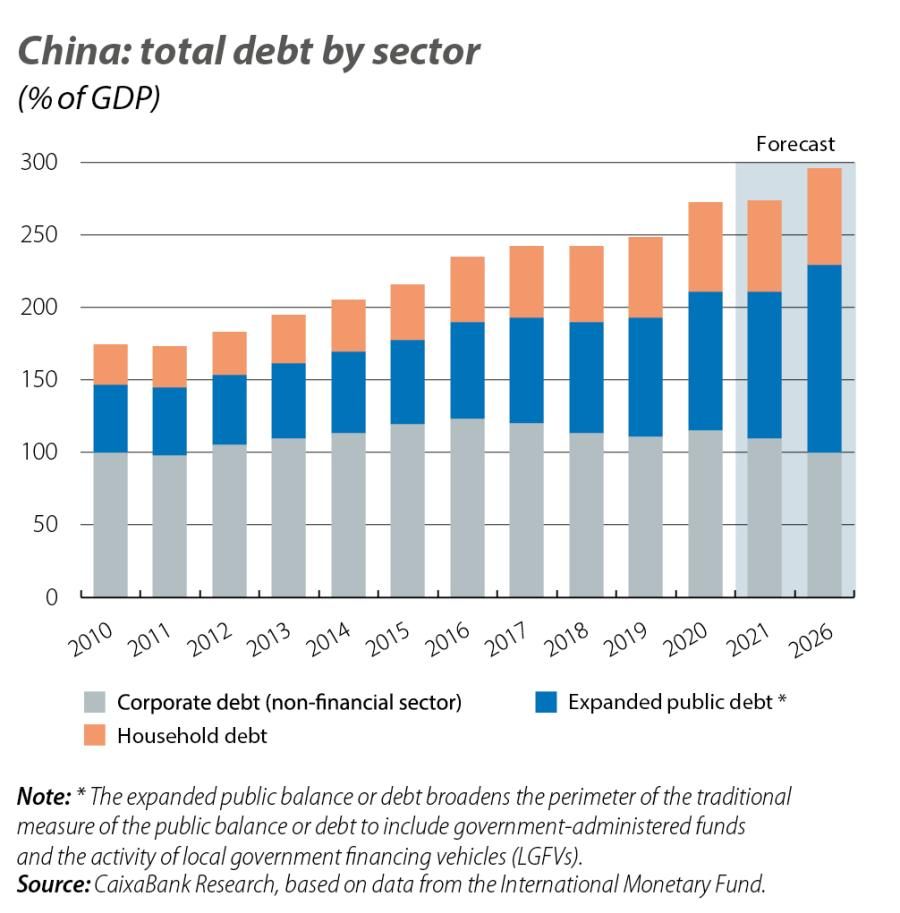China’s real estate sector (part II): emergency landing or low-altitude flight?
In mid-2020 the Chinese government announced a series of strict rules on access to credit in the real estate sector, which had historically followed a growth model based on high leverage. However, these measures not only managed to limit debt in the sector, but also exposed its vulnerabilities. In this article, we look at the biggest risks of this strategy.

The total debt of the Chinese economy stood at 274% of GDP at the end of 2021.1 Conscious of the risks of an excessive accumulation of debt and the need to rebalance the country’s economic growth model, in recent years the Chinese authorities have endeavoured to contain corporate debt (which peaked in 2016 at 123% of GDP, see first chart). In this regard, in mid-2020 the government announced a series of strict rules on access to credit in the real estate sector, which had historically followed a growth model based on high leverage.
- 1. According to IMF estimates.

In particular, in order to access bank credit, developers must comply with the so-called «three red lines».2 However, these measures not only managed to limit debt in the sector, but also exposed its vulnerabilities. In this context, some of the biggest developers are facing severe liquidity problems. The biggest risk of this strategy of deleveraging the real estate sector is that of contagion between developers, as well as contagion to other parts of the economy that are exposed to the real estate sector.
- 2. The first red line includes a 70% limit on the liability-to-asset ratio, excluding advance proceeds from housing sales. The second and third red lines correspond to a limit of 100% in the net leverage ratio and a minimum coefficient of 1 in the liquidity ratio (relative to short-term debt).
A series of «controlled implosions» of some of the developers that are in a weaker financial position could lead to contagion from the insolvent developers to other more solvent ones. That is, there is a risk that the conditions of the supply and demand of credit in the real estate market could deteriorate in such a way – owing to the loss of consumer and creditor confidence – that even the more solvent developers (e.g. those that would comply with the red lines under normal conditions) could lose access to the credit market while facing a sharp drop in housing demand.
In this regard, there is evidence that some developers with better debt and liquidity ratios, which until a few months ago had higher credit ratings, are now facing liquidity problems, and these are being further exacerbated by declining home sales.
Looking at the financial situation of some of the biggest firms in the sector (see table), with total liabilities amounting to around 2 trillion dollars, we see that the vast majority have a leverage ratio well above the industry average, even reaching almost five times the average in some cases. Moreover, among the top five developers (whose liabilities amount to 1 trillion dollars), three would not meet the first red line in the next two years, and all five have at least two ratios (leverage, liquidity or profitability) that are among the worst in the sector. If we add to these companies those with a credit rating already below BB+ (the threshold for a company to be considered investment grade) then the total liabilities of all these companies at risk of facing short-term liquidity problems, or even imminent default (the case of Evergrande), would exceed 1.5 trillion dollars. This equates to 80% of the market, in terms of total assets, being at risk of facing liquidity problems in the short term.3 On the other hand, it is estimated that the biggest developers will need an additional 200 billion dollars of liquidity to comply with the three red lines laid down by the Chinese government. Focusing on the top five developers, these additional funding needs would represent 20% of their assets.4
- 3. These figures refer to assets and liabilities recorded on the developers’ balance sheets. However, since the Chinese authorities began to take measures to reduce corporate debt, many developers have become more dependent on advance proceeds from sales of unfinished homes and have resorted to off-balance-sheet vehicles to obtain liquidity, thus avoiding regulatory scrutiny.
- 4. Estimate by Goldman Sachs, assuming that, although they will lose access to the offshore debt issue market, the developers will be able to refinance their bank loans and the restrictions on the use of advance proceeds will remain in place (approximately 20% not available to cover debt). This estimate does not include off-balance sheet debt or financing activities.

On the other hand, a series of uncontrolled defaults in the sector could lead to a large number of unfinished homes (usually with a high percentage paid in advance), a cascade of defaults in sectors closely linked to real estate (the most exposed sectors) and sharp declines in house prices. This scenario could generate tremors in the most exposed upstream sectors, both in the manufacturing sector, among producers of basic metals or machinery and equipment, and in the services sector, in commercial and financial activities.5
With regard to the financial sector, and despite the high degree of uncertainty over each bank’s degree of exposure to developers at risk of default, loans to the real estate sector account for 7% of total bank loans, while mortgages represent 21% of the total. Even considering that a portion of other bank loans are secured with real estate collateral, the banking sector’s direct exposure to the real estate sector is not excessive. In any case, a scenario of successive uncontrolled defaults, with potentially systemic implications for the financial sector, seems somewhat unlikely given the Chinese authorities’ ability to intervene in the economy and the willingness they have already demonstrated to isolate small investors in default processes as much as possible and to minimise the economic impact of a slowdown in the sector.
- 5. For further details, see the Focus «China’s real estate sector: size does matter» in the MR01/2022.
Even when the short-term liquidity risks dissipate, the recovery of the real estate sector will be slow, given the degree to which developers are currently leveraged and the underlying demographic trends. Before the turbulence ends, the immediate future (and even the survival) of many companies in the sector, as well as in other highly exposed sectors, will depend on the restoration of investor confidence. In order to avoid a «self-fulfilling prophecy» – that is, a situation in which the current weakness of the real estate market leads to a collapse in prices, which in turn would reinforce the loss of confidence and the contagion to the banking sector – the deployment of monetary and fiscal policy measures aimed at specific parts of the sector will be key in order to facilitate business restructuring, guarantee access to credit for small investors and curb the risks posed by advance housing sales. With passenger confidence guaranteed, even if at a lower altitude, the aircraft could remain airborne.
- 1. According to IMF estimates.
- 2. The first red line includes a 70% limit on the liability-to-asset ratio, excluding advance proceeds from housing sales. The second and third red lines correspond to a limit of 100% in the net leverage ratio and a minimum coefficient of 1 in the liquidity ratio (relative to short-term debt).
- 3. These figures refer to assets and liabilities recorded on the developers’ balance sheets. However, since the Chinese authorities began to take measures to reduce corporate debt, many developers have become more dependent on advance proceeds from sales of unfinished homes and have resorted to off-balance-sheet vehicles to obtain liquidity, thus avoiding regulatory scrutiny.
- 4. Estimate by Goldman Sachs, assuming that, although they will lose access to the offshore debt issue market, the developers will be able to refinance their bank loans and the restrictions on the use of advance proceeds will remain in place (approximately 20% not available to cover debt). This estimate does not include off-balance sheet debt or financing activities.
- 5. For further details, see the Focus «China’s real estate sector: size does matter» in the MR01/2022.



